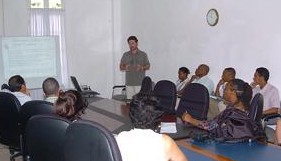Source: Seychelles Nation - 17.02.2005
Tackling the problems of beach erosion and establishing an early warning system and disaster management plan should be Seychelles’ main environmental priorities following the December 26 tsunami, scientists have said.
A team from the United Nations Environment Programme (Unep), in Seychelles to study the environmental impacts of the disaster, highlighted problematic erosion at Anse Kerlan on Praslin and 25 other hotspots of beach erosion around Seychelles that were worsened by the tidal waves.
The Unep team, led by biodiversity specialist Mark Collins, studied the effects of the tsunami on coral reefs, beaches and other aspects of the environment during the past week. The mission was drawn up after discussions between Minister of Environment and Natural Resources Ronny Jumeau and Unep director Klaus Toepfer at last month’s small islands meeting in Mauritius.
Presenting the preliminary findings recently to a panel of environment officials including the minister, Mr Collins said that in addition to some coastlines needing to be stabilised, increased capacity within some of the country’s scientific bodies would be required to improve monitoring and put in place an early warning system.
The Unep team also confirmed that reefs in Seychelles had been affected, this on top of the 1998 bleaching event that had killed most of the corals in the first place.
Mr Collins stressed the importance of “integrated management across all ecosystems,” saying that activities in mountains, forests and wetlands could eventually be felt on the coasts and even on the reefs.
December’s tsunami, he added, also showed the importance of beach vegetation and reefs in absorbing the impact of rising waters. This is especially important in places like Anse Kerlan, where beachside properties and homes have been at risk, Mr Collins said.
Unep estimates the initial stabilisation of Anse Kerlan, as well as setting up the early warning system and capacity building programmes for staff, would amount to some R23,100,000. Another 20-40 million Euros might be needed to stabilise the remaining 25 erosion hotspots, but Mr Collins said an alternative but much more patient route would be “to let nature take its course.”
He did say, however, that proposals for assistance from Seychelles, given that its current environmental capacity was ahead of many countries, would most likely be well received by Unep and the international scientific community.
After the presentation, environment principal secretary Rolph Payet indicated that the ministry would be working with Unep and potential funding bodies like the Indian Ocean Commission and the Global Environment Facility to help implement the plan.
Bilateral talks are also being held for more assistance, as both the Netherlands and Australia have expressed interest in future environment initiatives in Seychelles.
The erosion problems at Anse Kerlan are expected to be a priority, but despite public pressure for a quick fix Mr Payet said that the ministry would be looking for a long-term solution with overseas assistance.
“We need to get it right,” he said, adding that some temporary measures may worsen the situation in the long run.
An early warning system, which Unep said should involve tidal gauge stations and sea buoys, is also in the cards along with measures to strengthen the Seychelles Centre for Marine Research and Technology – Marine Parks Authority and the National Meteorological Services.
Mr Payet suggested that Seychelles would not wait for a regional early warning system to be put in place before developing its own, although the country would gladly participate in any such system as soon as it is established. “We’re not waiting for anyone. We can’t bank on any one's initiative.”
Another recommendation from the Unep team – raising awareness about some of the issues brought up by the tsunami, like clearing coastal vegetation and the importance of wetlands – would also be emphasised by the ministry this year, he added.
